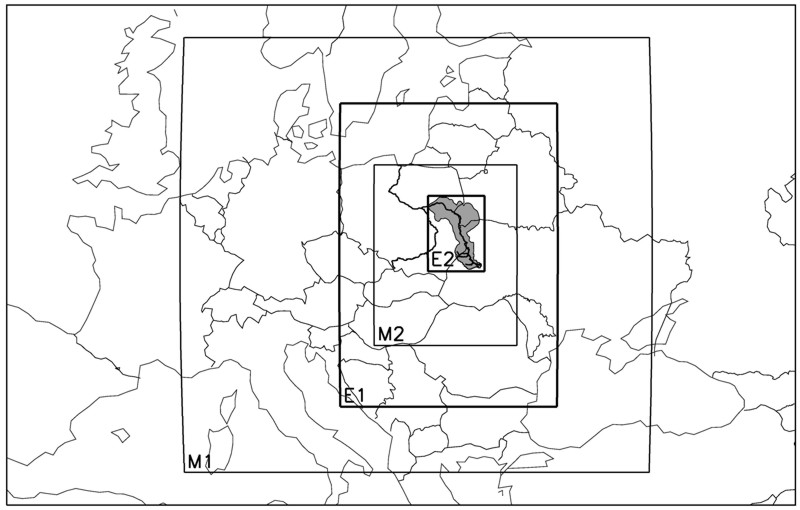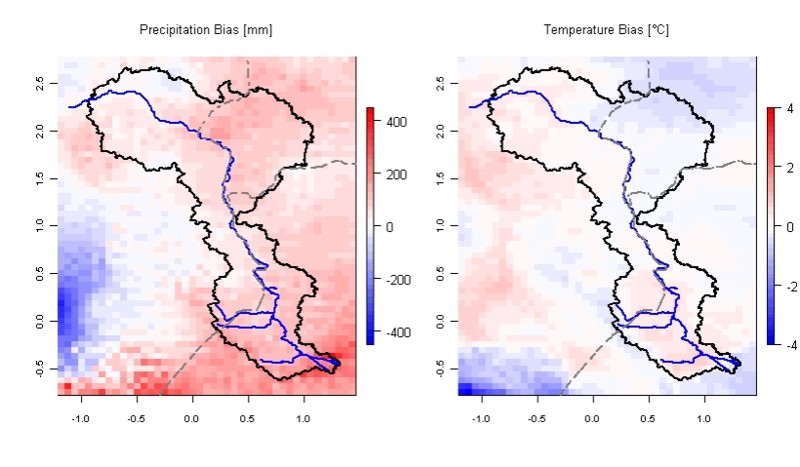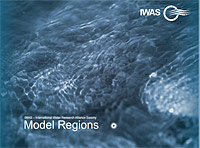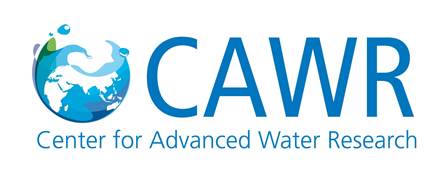Regional Climate Modelling
Tasks and objectives
Climate changes have a significant impact on the quality and quantity of water resources. This is particularly true for hydrologically sensitive regions. Inadequate water quality is one of the main problems that may affect the social welfare and economic development in expanding industrial areas of developing countries or emerging countries (like Ukraine).
Sustainable solutions to water problems that based on the integrated water resources management approach (IWRM) must take into account the influence of future climate changes on water resources. Successful IWRM, in hydrologically sensitive regions, requires robust as possible regional climate projections. Global climate projections are to coarse in their horizontal resolution.
The main objective for the IWAS model-region Eastern Europe (Ukraine, Poland, Belarus) is the projection of regional climate scenarios until the year 2100. The results of the climate scenarios are provided for each working group for the development of regional future scenarios and further impact analysis. But also the implementation of an appropriate regional climate model and thus the development of a methodology for downscaling of global climate projections itself is an important part of the task.
Methodology
Dynamic downscaling is based on numerical modelling of atmospheric processes on a regional scale. A regional grid with a higher spatial resolution is embedded (nesting) in the coarse grid of a global climate model (GCM). The output of the global climate model serves as external driver at the boundaries of the regional grid.
The Regional Climate Model CCLM
Dynamical downscaling is performed with the Regional Climate Model (RCM) COSMO Climate Local Model (CCLM) in the IWAS project. CCLM is based on a version of the Local Model (LM), which was developed by the German Weather Service (DWD). It calculates the atmospheric variables on the basis of primitive (in the sense of original) thermo-

hydrodynamic equations describing compressible flow in a moist atmosphere on a regular latitude/ longitude grid with a rotated pole and a terrain following height coordinate. CCLM was designed for applications on the meso-ß (20-200 km) and meso-γ scale (2-20 km). Currently, the model is developed and maintained by the CLM-Community (www.clm-community.eu).
Modelling approach
Climate simulations with a high spatial resolution of about 7 km are carried out with CCLM in the model-region Ukraine. The GCM ECHAM5 of MPI Hamburg (http://www.mpimet.mpg.de/en/science/models/echam.html) serves as external drive. Due to the high downscaling factor (about 29) a so called double-nesting approach was chosen. CCLM runs in the first step with a spatial resolution of 0.44° (50 km) driven by the GCM ECHAM5. In the second step, a regional grid with a spatial resolution of 0.0625° (7 km) is used, and the results of the first nesting serve as drive. According to the double nesting approach, the CCLM was applied for two different model domains covering a central part of Europe for the first nesting and parts of Poland, Belarus, and the Ukraine for the second nesting (Fig. 1). Table 1 lists characteristic model settings for this study.

Fig. 1: The Western Bug catchment (shaded area) within the two model domains (M1) and (M2) and the respective evaluation areas (E1) and (E2)
Table 1: Model configuration
| Modell Parameter | 1. Nesting | 2. Nesting |
|---|---|---|
| Grid resolution | 0.44° | 0.0625° |
| Number of grid points | 51 x 47 | 135 x 107 |
| Rotated north-pole | lon -158.3°, lat 39.7° | lon -156.9°, lat 39.7° |
| Model time step | 240 sec. | 40 sec. |
| Output time stepritt | 3 hr | 3 hr |
| Integration scheme | Runge Kutta | Runge Kutta |
| Convection scheme | Tiedtke | Tiedtke |
Results
Evaluation
The evaluation of the model performance is an important step within the downscaling procedure of global climate projections. A climate model should be able to reproduce satisfactorily the climatic conditions of the past in order to simulate trustworthy future projections. CCLM was evaluated with the control run for the period 1961-1990 (climate normal period). The control run was driven by reanalysis data (ERA40). The model results were compared with regionalized observational data. The long-term mean values of the 2 m temperature were well reproduced by the model (Fig. 2)., but the long-term means of precipitation totals show significantly higher deviations from the reference data. This illustrates the necessity of applying an appropriate bias correction method in order to use the model results as input for further studies (eg. water balance modelling).

Abb. 2: Bias of the long-term yearly means for precipitation and 2m temperature (difference of CCLM control run and observations)
Climate projections
The IPCC SRES climate scenarios A2 and B1, for the period 2010 to 2100, will be processed for the Western Bug river catchment. The model runs from 2010 to 2050 have already been computed and analyzed. Preliminary results for the 2 m temperature are shown in Fig. 3. Both scenarios show a small but significant increase in mean annual temperatures for the mid-21th century in the Western Bug river catchment. The modelling of climate scenarios will be continued until the year 2100.
![Climate change signal of the 2 m temperature [° C] for the Western Bug river catchment Climate change signal of the 2 m temperature [° C] for the Western Bug river catchment](/export/data/14/40628_CMS_IMAGE.jpg)
Abb. 3: Climate change signal of the 2 m temperature [° C] for the Western Bug river catchment (SRES scenario - control run), area means
Contact
Dr. Dirk Pavlik
Technische Universität Dresden
Institute of Hydrology and Meteorology
Chair of Meteorology
01062 Dresden, Germany
![]()
![]() dirk.pavlik@tu-dresden.de
dirk.pavlik@tu-dresden.de
Dipl. Met. Dennis Söhl
Technische Universität Dresden
Institute of Hydrology and Meteorology
Chair of Meteorology
01062 Dresden, Germany
![]()
![]() dennis.soehl@tu-dresden.de
dennis.soehl@tu-dresden.de
Helmholtz-Center for Environmental Research (UFZ)
Department of Environmental Informatics
Permoser Str. 15
04318 Leipzig, Germany
![]()
![]() dennis.soehl@ufz.de
dennis.soehl@ufz.de
Publications
Journals
D. Pavlik, D. Söhl, Th. Pluntke, A. Mykhnovych, Ch. Bernhofer (2011): Dynamic downscaling of global climate projections for Eastern Europe with a horizontal resolution of 7km. IWAS Special Issue in Environmental Earth Sciences, doi:10.1007/s12665-011-1081-1.
Contribution to conferences
D. Pavlik, D. Söhl (2010): Regionale Klimaprojektionen für das Einzugsgebiet des Westlichen Bug (Ukraine/Polen/Weißrussland). DACH Meteorologentagung, 20.-24.09.2010, Bonn.
D. Pavlik, D. Söhl (2010): Application and Evaluation of a Regional Climate Model for Eastern Europe. International Conference on Global and Regional Climate Changes, 16.11.-19.11.2010, Kiew.
D. Pavlik, D. Söhl (2010): Dynamic downscaling of global climate projections for modelling the future regional water balance and water quality in Ukraine. In: H. Steusloff (2010) (Hrsg.): IWRM – Integrated Water Ressources Management. IWRM Karlsruhe 2010 - Conference proceedings. (ISBN 978-3-86644-545-1).




.png)
.png)
